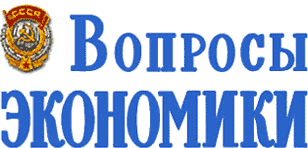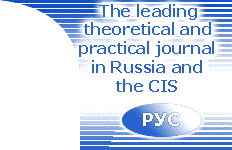|
MACROECONOMIC POLICY |
|
|
PROBLEMS OF THEORY |
|
|
FISCAL REFORM AND ENTERPRISE |
|
|
LABOR MARKET |
|
|
|
REFLECTIONS ON THE BOOK |
- D. L'vov - Eight Months from the Life of the Country (on the Book by E. Primakov "Eight Months plus...")
|
|
CRITIQUE AND BIBLIOGRAPHY |
- Savchenko P.V. In Search for Truth. Selected Works
|
|
E.YASIN. Economic Growth as an End and as a Means
|
|
Russia has reached the stage of transformation of the economy and the society, when by logic of "Washington consensus" economic growth has to be resumed. Growth needs investments, but the Russian economy adopts them badly. The proposal was offered: for sterilization of "excessive" export receipts it is necessary to pay foreign debt according to the schedule and better still to pay in advance and to maintain outflow of capital. The author argues that a solution lies in strengthening of bank system and financial markets. Banks are a key means of a break-through. If financial markets prevail as mechanisms of mobilization and allocation of financial recourses, conditions for economic growth will be created.

|
|
A. GRANBERG. The Strategy of Territorial Social and Economic Development
of Russia: from Idea to Implementation
|
|
The author proves necessity of strengthening of territorial aspect of long-term forecasting and programming of national economy. Substantive provisions of strategy of territorial development (STD) of Russia are stated: overcoming of negative tendencies of the 1990-s, geostrategic interests of Russia and evolution of economic space under conditions of globalization, problems of modernization of economic space, scripts of development of seven macroregions. The further detailed elaboration and integration of STD may be carried out in two lines: development of problem-functional blocks (demography and migration, settling, power, transport, etc.); development and synthesis of regional strategy. Mechanisms of realization of STD are designated.

|
|
V. MORGUNOV. Determination of Allowed Rate of Return under Price
Regulation of Natural Monopolies: Two Concepts
|
|
In the article the two approaches to determination of allowed rate of profit under price regulation are considered. In Russia the concept of "necessary profit at discretion" is inherited from the planned economy. Its use does not create proper motivation to private investments in regulated industries. In the article the statistical data are analyzed and it is demonstrated that Russian firms hardly ever go to capital markets for raising capital. It is argued that the allowed rate of return under price regulation must cover at least the cost of capital. The obstacles to implementation of this concept in the Russian practice are discussed.

|
|
L. GREBNEV. What not only Economists Know
|
|
Author continues the discussion on the XX century's contribution into the economic theory that was opened by of W. Baumol's (#2) and A. Nesterenko's (#7) articles. He compares methodological approaches of pointed authors, based accordingly on "insular" and "continental" traditions of European philosophy. Author develops some topics of А. Nesterenko: "subject-object" relations in the economy, alienation problem and the concept of "technological styles". The special emphasis is made on the problem of the "time co-ordination" of economic decisions. That analysis allows us to include "co-ordinated economy" in the number of main ideal types alongside with "natural economy" and "market economy".

|
|
S. AUKUTSIONEK, A. BATYAEVA. What Tax Reforms Benefit the State?
|
|
The article deals with study of the enterprises response to changing tax rates. The authors examine various tax reform scenarios centering in cuts and increases in the rates of three basic taxes: the profit tax, the VAT, and the unified social tax. What will the federal treasury gain, and what will it lose? What will be the changes in output and capital investment? What implications will the accumulated producers' debt have in this situation? These issues are studied on primary information about activities and behavior of enterprises, which was obtained as a result of a special survey of industrial enterprises conducted by the Russian Economic Barometer in the end of 2000.

|
|
А. BATYAEVA. What Prevents from Paying Taxes?
|
|
The article examines the situation of enterprise tax debt and the extent of its influence on economic activity and financial condition of enterprises. The main conclusion is that although there is a number of positive developments (overdue debt has declined, performance of enterprises has improved), the general negative tendency is hard to overcome. The point is that enterprise directors see no harm in overdue payments to the government. They believe that they never face any unavoidable retribution.

|
|
S. AFONTSEV, R. KAPELYUSHNIKOV. Structural Characteristics of Enterprises and Their
Fiscal Behavior |
|
Adequate tax reform proposals should rest on the distribution of enterprises' tax burden and their expected reactions to possible changes in the fiscal regime. The authors analyze tax behavior of Russian enterprises depending of their geographic and industrial affiliation, ownership patterns, market structure, export intensity, and the aggregate tax burden. They also consider managers' projections concerning the expected changes in output and investment induced by various versions of the tax burden alleviation. Conclusions are made in respect to the probable impact of changes in the profit tax, the VAT, and the unified social tax on enterprise activity.

|
|
T. CHETVERNINA, S. LOMONOSOVA. Social Protection of Hired Workers in the New Private
Sector: Myths and Reality
|
|
This article investigates some of the special features of labor relations and social protection in the private sector. The article draws on empirical data collected by the labor market group at the Institute of Economics of the Russian Academy of Sciences during late 1999 - early 2000. The data confirm that informal relations are widespread in the private sector in respect of hiring, working conditions, and remuneration. The article concludes that hidden forms of hiring and remuneration are to a great extent the result of the lack of state control to ensure that labor legislation is observed in the private sector. As a result, private sector employees' apparent advantage of high wages "compensates" for a lack of job and wage security and a low level of social protection. According to the authors, the legal nihilism of the employers coupled with the legal illiteracy of most employees means that the adoption of the new Labour Code will have no real effect on the position of those employed in the private sector.

|
|
G. MONUSOVA. Non-Employment in Russia: Forced or Voluntary?
|
|
The transition to a market economy is associated with reduction in employment and rise in unemployment. Most of the labor market studies focus on these two interconnected dimensions. Individuals chosing to leave the labor market usually attract little attention, since their inactivity is assumed as voluntary. In this article, the author explores the nature and structure of the non-employment. Which factors are responsible for reduction in the employment level in the Russian economy? How do various demographic groups of population react to factors pushing them out of employment? Using household survey data, the author shows significant heterogeneity among non-employed, in general, and inactive, in particular. Reduction in the labor supply due to intensification of labor market withdrawal turns out to be highly unstable: a significant portion of those left for inactivity is potentially quite mobile and ready to return to the market. Therefore, the economically inactive population deserves more attention from policy makers taking into account its potential influence on labor market performance.

|
|
T. RAZUMOVA, S. ROSHCHIN. Economic Analysis of Factors of Secondary Employment
|
|
This paper investigates labor supply in the form of secondary employment. Several hypotheses are tested on RLMS (Russia Longitudal Monitoring Survey) database - the effect of individual and household income on secondary employment decisions, first job parameters dependence on second job characteristics, different causes of secondary employment: various professional statuses of jobs, limitations of time on the first job, labor mobility. Secondary employment depends on wage arrears and to some extent on labor mobility. The prior causes of secondary employment are various professional statuses of jobs and time limits on the first job.

|
|
I. TSAPENKO. How to Counteract Illegal Migration
|
|
Dimensional and structural characteristics of illegal immigration into developed Western countries from Asia, Africa, Latin America and recently from post-socialist states including FSU along with contradictory effects of large-scale immigration on economic activities and social developments in recipient countries are analysed. Measures aimed at limiting the scale of illegal immigration are discussed.

|



